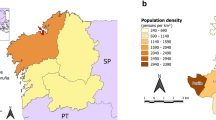Abstract
With the increase of public awareness and of their involvement in conservation projects, flagship species have become a common tool to appeal to people’s interest. Yet, the effectiveness of this approach depends on the proper communication of the importance of conserving these species. Using two projects aiming to control the invasive American mink, I illustrate how communication could positively or negatively affect the involvement of the public, and consequently the success of the projects. The Scottish mink control project managed to increase the number of volunteers involved by adapting the selection of flagship species and their communication to the public needs. Meanwhile, the Spanish project, while no volunteers are involved yet, has increased the public awareness using the European mink as native flagship species. However, as its nativeness remains unconfirmed I suggest there is a high risk of potential miscommunication with the public that can negatively impact their perception.
Similar content being viewed by others
References
Aars J, Lambin X, Denny R, Griffin AC (2001) Water vole in the Scottish uplands: distribution patterns of disturbed and pristine populations ahead and behind the American mink invasion front. Anim Conserv 4:187–194. doi:10.1017/S1367943001001226
Barros Á, Romero R, Munilla I, Pérez C, Velando A (2016) Behavioural plasticity in nest-site selection of a colonial seabird in response to an invasive carnivore. Biol Invasions 18(11):3149–3161
Beirne C, Lambin X (2013) Understanding the determinants of volunteer retention through capture-recapture analysis: answering social science questions using a Wildlife Ecology Toolkit. Conserv Lett 6:391–401. doi:10.1111/conl.12023
Bowen-Jones E, Entwistle A (2002) Identifying appropriate flagship species: the importance of culture and local contexts. Oryx 36:189–195. doi:10.1017/S0030605302000261
Bryce RL (2006) The ecosystem engineering and trophic effects of the water vole : species loss and ecosystem processes. University of Aberdeen, Aberdeen
Bryce R, Oliver MK, Davies L et al (2011) Turning back the tide of American mink invasion at an unprecedented scale through community participation and adaptive management. Biol Conserv 144:575–583. doi:10.1016/j.biocon.2010.10.013
Caro T (2010) Conservation by proxy: indicator, umbrella, keystone, flagship, and other surrogate species. Island Press, Washington
Clavero M (2014) Shifting baselines and the conservation of non-native species. Conserv Biol. doi:10.1111/cobi.12266
Clavero M (2015) Non-Native species as conservation priorities: response to Díez-León. Conserv Biol. doi:10.1111/cobi.12524
Delaney DG, Sperling CD, Adams CS, Leung B (2008) Marine invasive species: validation of citizen science and implications for national monitoring networks. Biol Invasions 10:117–128. doi:10.1007/s10530-007-9114-0
Fraser EJ, Macdonald DW, Bryce R, Lambin X (2014) Controlling invasive species by empowering environmental stakeholders: ecotourism boat operators as potential guardians of wildlife against the invasive American mink. Oryx 48:605–612. doi:10.1017/S003060531300046X
Grahame K (1908) The Wind in the Willows
Hart PS, Larson BMH (2014) Communicating about invasive species: how “driver” and “passenger” models influence public willingness to take action. Conserv Lett 7:545–552. doi:10.1111/conl.12109
Hou D (2016) Divergence in stakeholder perception of sustainable remediation. Sustain Sci. doi:10.1007/s11625-015-0346-0
Jepson P, Barua M (2015) A theory of flagship species action. Conserv Soc 13:95. doi:10.4103/0972-4923.161228
Kalinkat G, Cabral JS, Darwall W et al (2016) Flagship umbrella species needed for the conservation of overlooked aquatic biodiversity. Conserv Biol. doi:10.1111/cobi.12813
Maran T, Skumatov D, Gomez A et al (2016) Mustela lutreola. IUCN Red List Threat Species. doi:10.2305/IUCN.UK.2016-1.RLTS.T14018A45199861.en
Melero Y (2007) Study of the demographic parameters of the endangered European mink in the Spanish population. PhD Thesis, University of Barcelona, Barcelona
Melero Y, Palazón S, Bonesi L, Gosàlbez J (2010) Relative abundance of culled and not culled American mink populations in northeast Spain and their potential distribution: are culling campaigns effective? Biol Invasions 12:3877–3885. doi:10.1007/s10530-010-9778-8
Melero Y, Robinson E, Lambin X (2015) Density- and age-dependent reproduction partially compensates culling efforts of invasive non-native American mink. Biol Invasions 17:2645–2657. doi:10.1007/s10530-015-0902-7
Michaux JR, Hardy OJ, Justy F et al (2005) Conservation genetics and population history of the threatened European mink Mustela lutreola, with an emphasis on the west European population. Mol Ecol 14:2373–2388. doi:10.1111/j.1365-294X.2005.02597.x
Nowak RM (1999) Walker´s mammals of the world. The Johns Hopkins University Press, Baltimore
Oliver MK, Piertney SB, Zalewski A et al (2016) The compensatory potential of increased immigration following intensive American mink population control is diluted by male-biased dispersal. Biol Invasions. doi:10.1007/s10530-016-1199-x
Saint-Girons MC (1994) Wild mink (Mustela lutreola) in Europe. Nature and Environment 54, Strassbourg
Simberloff D (1998) Flagships, umbrellas, and keystones: is single-species management passé in the landscape era? Biol Conserv 83:247–257. doi:10.1016/S0006-3207(97)00081-5
Smith AM, Sutton SG (2008) The role of a flagship species in the formation of conservation intentions. Hum Dimens Wildl 13:127–140. doi:10.1080/10871200701883408
Tintarev N, Melero Y, Sripada S et al (2012) MinkApp: generating spatio-temporal summaries for nature conservation volunteers. Proceedings of the International Conference of Natural Language generation. Association for Computational Linguistics, Utica, pp 17–21
Velando A, Munilla I (2008) Plan de Conservación del Cormorán moñudo en el Parque Nacional de las Islas Atlánticas. Vigo
Verissimo D, MacMillan DC, Smith RJ (2011) Toward a systematic approach for identifying conservation flagships. Conserv Lett 4:1–8. doi:10.1111/j.1755-263X.2010.00151.x
Veríssimo D, Fraser I, Girão W et al (2014) Evaluating conservation flagships and flagship fleets. Conserv Lett 7:263–270. doi:10.1111/conl.12070
Zuberogoitia I, Põdra M, Palazón S et al (2016) Misleading interpretation of shifting baseline syndrome in the conservation of European mink. Biodivers Conserv 25:1795–1800. doi:10.1007/s10531-016-1156-0
Acknowledgements
Thanks to Catherine Preece for revising the English. I belong to the research group Biodiversitat i evolució en ecosistemes mediterranis SGR-00913 from CREAF.
Author information
Authors and Affiliations
Corresponding author
Additional information
Communicated by David Hawksworth.
Rights and permissions
About this article
Cite this article
Melero, Y. Communication of flagship species in conservation: lessons from invasive management projects. Biodivers Conserv 26, 2973–2978 (2017). https://doi.org/10.1007/s10531-017-1389-6
Received:
Revised:
Accepted:
Published:
Issue Date:
DOI: https://doi.org/10.1007/s10531-017-1389-6




